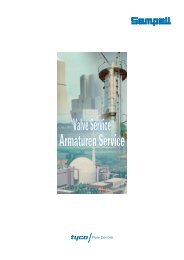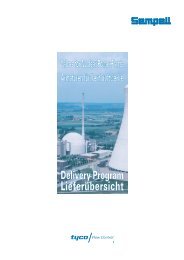You also want an ePaper? Increase the reach of your titles
YUMPU automatically turns print PDFs into web optimized ePapers that Google loves.
92<br />
Reheater Isolating Device<br />
Sizes 16”– 36”<br />
ASME B16.34<br />
Introduction<br />
Hundreds of thousands of pounds per day are lost<br />
whenever a power plant closes!<br />
Repairs of installation facilities are frequently a part of a<br />
planned programme of maintenance. The downtime<br />
cost is figured into the operating budget. Even so, any<br />
innovation which can save time will also save significant<br />
amounts of money.<br />
A chief method for determining the effectiveness of the<br />
repairs done on plant pipelines is hydrostatic testing. In<br />
one area of a plant, the reheat tubes located in the<br />
boiler and the pipelines adjacent to the boiler, testing<br />
has been a time consuming and costly problem.<br />
Isolation of the tubes from the pipeline has been done<br />
by mechanically forcing a blind flange between two<br />
flanges welded into the line. This procedure is slow,<br />
difficult, awkward and expensive.<br />
Isolating of the hot reheat section has been traditionally<br />
achieved by closing the turbine intercept valve.<br />
However, turbine manufacturers and utilities have<br />
expressed some concern in relying solely on the turbine<br />
intercept valve as a stop valve.<br />
The Dewrance Reheater Isolating Device, (R.H.I.D.),<br />
however, allows hydrostatic testing to be conducted<br />
easily and efficiently on both the cold and hot reheat<br />
lines. On the cold reheat line, from the high pressure<br />
turbine, temperatures average 600-700 ˚F and pressures<br />
range from 600-700 psi. The R.H.I.D. has an ASME 500<br />
Intermediate rating and cast carbon steel<br />
(A.216 Gr. WCB) body material to satisfy pressure<br />
temperature requirements of the cold reheat line.<br />
On the reheat line, from the Reheater Section of the<br />
boiler, temperatures range trom 900-1025 ˚F and<br />
pressures from 500 to 1200 psi. ASME Class 900# R.H.I.D.<br />
with cast alloy steel (A.217 Gr. WC9) body material is<br />
utilized on the hot reheat lines.<br />
The R.H.I.D. also reduces the possibility of damaging the<br />
intercept valve by providing a reliable seal in front of<br />
the turbine intercept valve.<br />
After installation the R.H.I.D. is merely a conduit and<br />
during normal operation it is open and free from any<br />
component parts.<br />
When hydrostatic testing is to be done the system can<br />
be isolated by merely placing a closure in the path of<br />
the flow. This is accomplished by removing the bolted<br />
pressure seal joint from the R.H.I.D. fitting the Isolating<br />
Closure into position and then resetting the pressure<br />
seal.<br />
The R.H.I.D. is uniquely designed to take advantage of<br />
two different forces for establishing seals. During<br />
regular service the Body/Bonnet Joint is mechanically<br />
preloaded prior to operation. When steam passes<br />
through the line it reinforces the mechanical seal with<br />
pressure. The Isolating Closure used during hydrostatic<br />
testing is similar; it is mechanically preloaded before<br />
testing and water pressure acting on the closure<br />
upgrades the seal.




